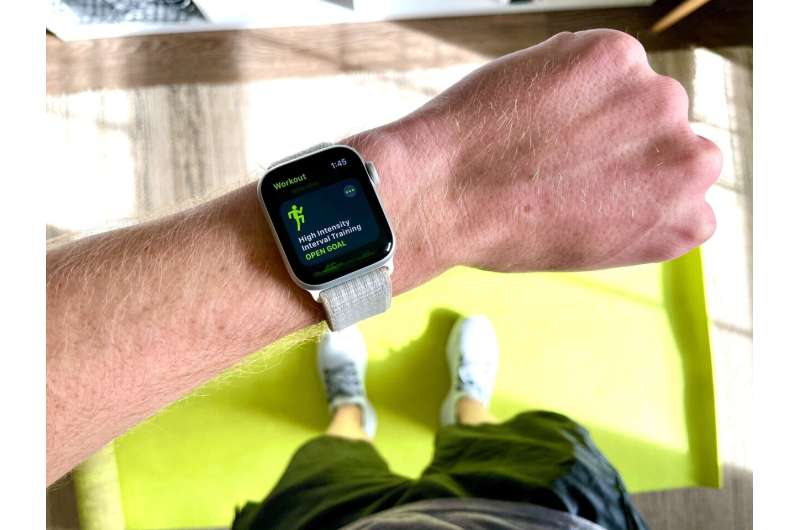
By the start of 2023, hundreds of millions of fitness trackers like Fitbits or Apple Watches had been sold to people who wanted to become or remain healthy. Many consumers rely on the step counts and activity tracking provided by these devices to help them increase their physical activity levels. Users may be more motivated to become physically active when these devices ask wearers to self-monitor their activity through on-screen prompts instead of simply supplying step counts and activity tracking, according to new research from Penn State.
In a new study published in the journal Health Psychology, 58 physically inactive young adults wore fitness tracking smartwatches for three months and were assigned goals to increase their activity levels.
Each day, participants received between zero and six prompts via a custom app on their smartwatch. In some cases, the watch provided feedback about how many minutes they had been active during the last two hours. In other cases, the watch prompted the wearer to report how many minutes they had been active during the last two hours.
The different types of prompts were not equivalently effective. Prompts that reported people’s activity were not associated with any increased physical activity by participants. Prompts that asked people to report their activity, however, were associated with participants taking hundreds more steps in a given day.
To record their estimated activity, participants pressed plus or minus icons on the smartwatch to add or remove five minutes from their activity estimates. Then, they clicked “Log it!” to record their responses. Whether or not study participants reported their activity accurately, the question forced them to think about how active they had been and, perhaps, how active they could have been. By reporting their active minutes in the smartwatch, participants seem to have engaged in the self-monitoring needed to motivate them to change their behavior, according to the researchers.
“For decades, scientists have known that getting people to self-monitor is the key for any type of behavior change, from improving diet to increasing physical activity,” said David Conroy, professor of kinesiology and human development and family studies at Penn State and lead author of this study. “The problem with self-monitoring, however, is that it is burdensome for people and difficult to complete for extended periods of time. For example, do you know how many minutes you were active yesterday?”
As wearable fitness trackers have become more common, these devices have provided behavioral feedback in the form of instantly available information about calories burned or steps taken.
“That feedback has largely taken the place of effortful self-monitoring: asking people to recall what they have done and monitor themselves,” Conroy continued. “This research suggests, however, that the process self-monitoring is very important.”
By varying the number of prompts that participants received during the 10 hours of the study each day, the researchers were able to determine the ideal number of times to prompt self-monitoring in a single day. Steps increased when participants received one self-monitoring prompt, were higher when participants received two prompts, and peaked when participants received three or four prompts. Participants who received three self-monitoring prompts took an average of 851 more steps than participants who received no prompts—a 30% increase over their baseline step counts. Once participants received five or more prompts, step counts went down, suggesting that it is possible to prompt people too often.
Although wearable devices frequently push feedback about step counts to users, step counts were unchanged for people who received behavioral feedback in the form of summaries of their activity over the past two hours, regardless of whether they received one, two, three, four, five, or the maximum possible of six prompts during a day.
Most intervention participants successfully increased their levels of physical activity. Before the study participants averaged 2,880 steps per day, and no participants were meeting United States government guidelines of a minimum of 150 minutes of moderate to vigorous physical activity each week. On average, participants were below 50% of recommended activity levels. By the study’s end, the average participant met the 150-minute per week recommendation. Daily steps also increased by 73%, for a total of nearly 5,000 steps per day, for study participants.
Conroy said the research team believes that reflecting on one’s activity forces a person to keep their goals at the front of their mind. Simply receiving that information is very passive, he said. When a person has to report what they accomplished over the last two hours, however, they reflect on what they did and did not do, which could motivate behavior changes over the rest of the day.
“What if thinking about your activity and reporting it is more effective for motivating behavior change than all those notifications you get about your step count or active minutes?” Conroy said.
“That would be good news, because wearable devices can easily prompt people to reflect on their behavior. Though these prompts are not commonly available today, these results suggest that some relatively simple changes to smartwatches and fitness trackers could help people get healthier and stay healthier.
“So, if the smartwatch or activity tracker you received over the holidays hasn’t helped you to achieve your physical activity goals yet, try asking yourself one simple question: how active have I been? But ask that three times a day.”
More information:
David E. Conroy et al, Dose–response relations between the frequency of two types of momentary feedback prompts and daily physical activity, Health Psychology (2023). DOI: 10.1037/hea0001271
Journal information:
Health Psychology
Source: Read Full Article


